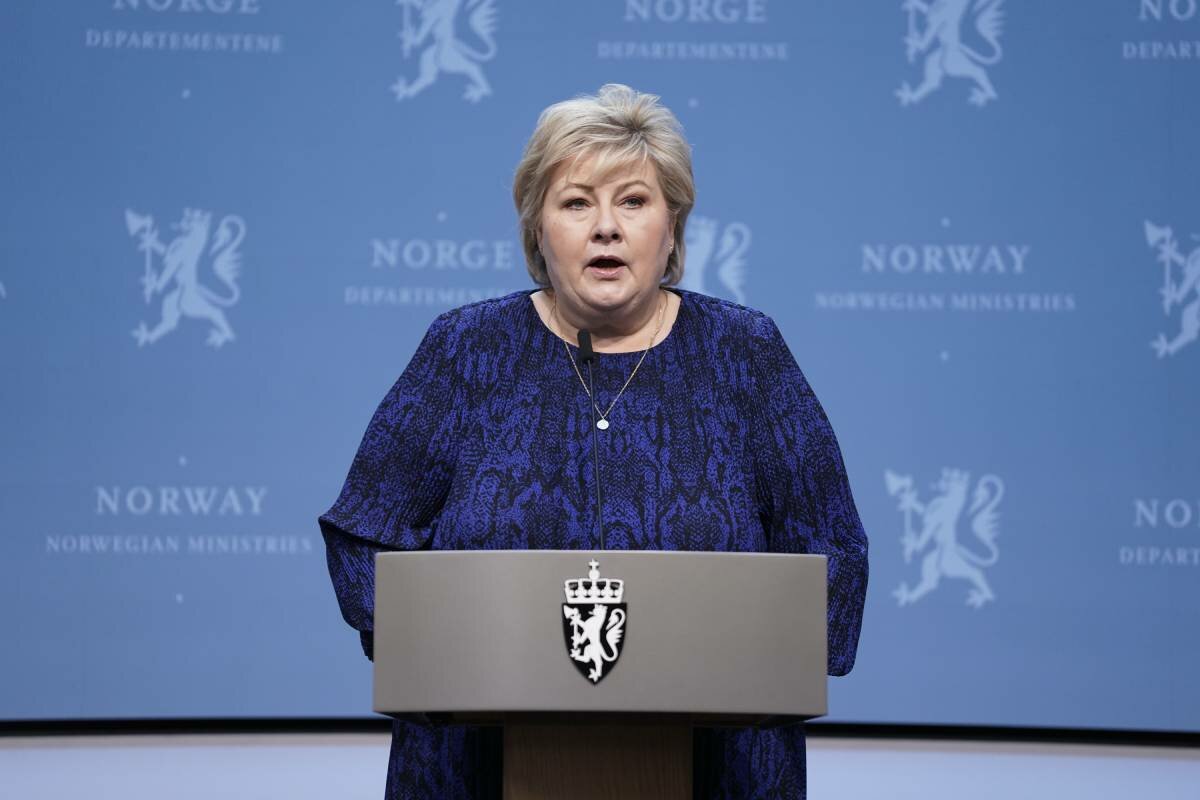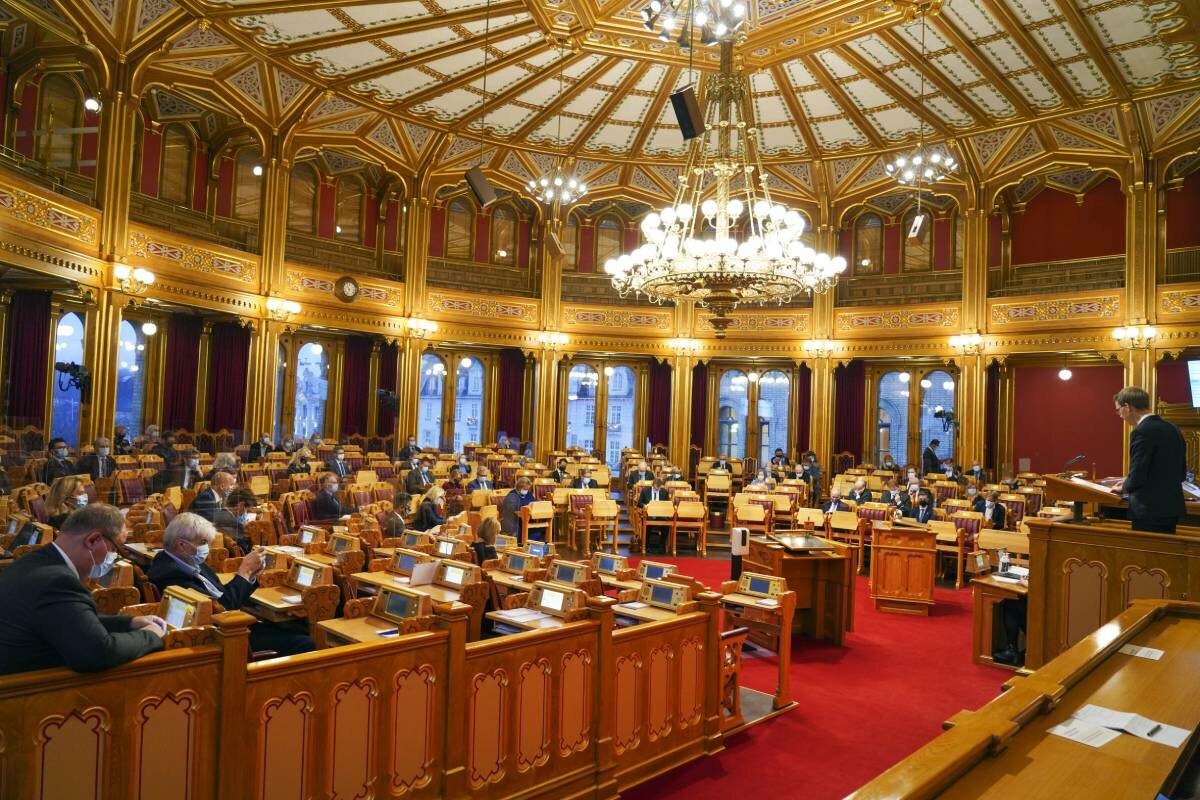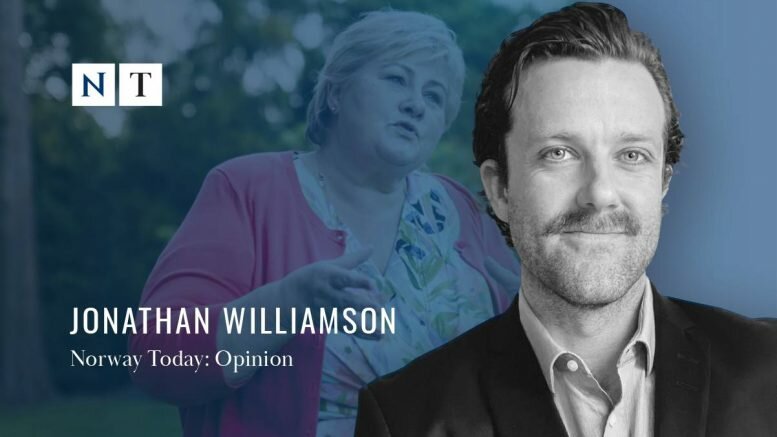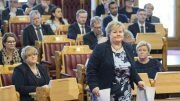Norway will head to the polls this September as Prime Minister Erna Solberg seeks another term in office. Her center-right government, in power for 8 years, has come under criticism lately for the handling of COVID and the sluggish vaccination rollout, ministerial scandals, an over-centralization of power, and a general sense of lethargy. New polling, from NRK, shows that a leftist change in government may very well occur. The increasing role of minor parties will, in essence, determine the outcome of the election with those parties on the political left to the center surging in political importance.
State of play in the parliament today
On September 13, the Norwegian parliamentary elections will be held. All 169 seats in the Norwegian legislature (Storting) will be contested.
Following the 2017 election, there are nine parties represented: the Labour Party (Arbeiderpartiet, AP) has 49 seats, the Conservative Party (Høyre, H) 45, the Progress Party (Fremskrittspartiet, FrP) has 27, the Centre Party (Senterpartiet, Sp) has 19, the Socialist Left Party (Sosialistisk Venstreparti, SV) has 11, the Liberal Party (Venstre, V) and Christian Democratic Party (Kristelig Folkeparti, KrF) both have 8 seats with the Green Party (Miljøpartiet De Grønne, MDG) and Red Party (Rødt) both accounting for just 1 seat each.
Prime Minister Erna Solberg, and her center-right coalition government, are seeking a third term, in office, from the voters. In power since the 2013 election, her party, Høyre, has received support from the FrP, V, and KrF accounting for a majority of 88 out of the 169 seats in the Stortinget.
During this current Storting session, Solberg has led both a majority and minority government. This majority (the first since 1985) was established with the support of the KrF in January 2019 however it turned into a minority government when the FrP pulled out of the coalition a year after this.
The opposition is composed of Jonas Gahr Støre’s AP but recent polling has shown that non-traditional parties are also experiencing high publicity. Sp, led by Trygve Slagsvold Vedum, is seen, by the media, as a possible political “kingmaker” whilst much has been made of the “millennial” styling of Rødt’s Bjørnar Moxnes.
The highs and lows of governing Norway
Prime Minister Erna Solberg looks to seek yet another term, what may be her third, in office. She is not only Norway’s second female Prime Minister (after Gro Harlem Brundtland) but is also the longest-serving Prime Minister from Høyre.
In office since 2013, her government has been keen to push reform in all aspects of society. Controversially starting off her first government budget with talk of a wealth tax reduction and scrapping of the inheritance tax she has, due to the COVID-19, ironically become the largest spender in government history much to the chagrin of fiscal conservatives. She has actively championed reducing oil as a source of national income, a so-called “green transition,” but has nonetheless changed little of either petroleum policies or their operations.
Municipal, regional, and health reform have occurred, often leading to more centralization of power with mixed satisfaction. Much public debate surrounded her government’s response to immigration challenges and the role of Islamic fundamentalism. Whilst championing women’s rights and girl’s education abroad, especially in Norway’s pitch for a non-permanent seat on the United Nations Security Council, her coalition partners were embroiled in controversial negotiations for doctors to have a “right of reservation” for abortion referral.
However, her time in office, whether it is extended another four years or not, will be forever characterized by the COVID-19 pandemic. This unprecedented social, political, economic, and public health crisis was a challenge like no other in post-war Norway.

A sense of stability rocked by recent scandals
Essentially, this election will be a referendum on the government’s handling, headed by Prime Minister Solberg, of the COVID-19 pandemic. The latest opinion poll, conducted by Norwegian Broadcasting (NRK), shows that, since April, Høyre has dropped almost 2.0%.
Seen by many voters as more of a steady hand on the ship of state than an inspiring and flamboyant leader, a sense of stability was the main reason for Solberg’s 8 years in power. The handling of the COVID-19 crisis, in Norway, won her government national and international praise. However, this stability has been waning in the past year or so as her government has been embroiled in multiple scandals.
The handling of the repatriation of a Norwegian women, linked to the Islamic State, and her children, caused the junior coalition partner, the FrP, to withdraw from the government in January 2020. The government has been plagued by several high profile scandals – among them the sale of Bergen Engines, the NAV scandal (though not solely responsible her government shares half the responsibility), Frøde Berg’s arrest in Russia, U.S. nuclear submarines docking near Tromsø, the slower than expected vaccination process and, of course, the infamous “sushigate” incident involving Prime Minister Solberg herself.
Though Solberg may remain relatively popular (a tough and experienced political battler, she is, after all, nicknamed “The Iron Lady”) it seems that these scandals will no doubt impact her reelection chances. These scandals only add to the sense that her government is running on borrowed time and more interested in preservation than governance.
Fierce competition looms amongst key challengers
Due to the nature of Norway’s political system, every election sees smaller parties play a role in the forming of a government. Size is not always important. Though polling suggests that Høyre and AP account for almost 50% of the vote, power will be won, or lost, with the help, or hindrance, of the minor parties. The goal for those smaller political parties is to receive, at least, 4% of the national vote. Parties crossing this threshold will receive an “equalization mandate” essentially meaning they will be represented in the Storting.
Prime Minister Solberg’s biggest threat is the AP. Its hopes are with, once again, the perennial “mer eller mindre mann,” Jonas Gahr Støre, who has been the leader of the opposition since 2014. He will be hoping to improve from the last election where the AP not only lost 6 seats but saw a 3.4% swing against them. With firsthand government experience, he is seen, like Solberg, as a safe, if not exactly inspiring, pair of hands.
Unlike Støre, Sp’s leader, Trygve Slagsvold Vedum, will hope to continue where his party left off at the 2017 election. A 4.8% swing to V saw them garner over 10% of the national vote. It has garnered its support mostly from rural, regional, and remote areas of Norway as it has its roots in the old Farmer’s Party. It is fiercely anti-E.U, protectionist, and wants more decentralization of power away from the big cities. Vedum has single-handedly turned this provincial party into a major force in today’s Norwegian political landscape tapping into the current anti-establishment mood the world over.
In the last election, only KrF and V achieved this vote, making them important beyond what their size would suggest. Yet there are high hopes that Rødt could cross this threshold, in September, due to a renewed interested (mainly fuelled by millennials) in progressive politics. Moxnes is no Norwegian Bernie Sanders but he may turn out to have a role to play in the forming of a government should this outcome occur.
The economy, municipal reform, and scandals loom large as key issues

As voters head to the polls in September, one issue will remain larger than others: the government’s handling of the COVID-19 pandemic. The Solberg government has overseen, in the past year or so, record levels of unemployment arise than fall, billions upon billions spent on targeted economic welfare support, social lockdowns throughout the country, and a pandemic sweep through the nation.
Norway is better placed than most countries, post-COVID due to a strong economy, small population, no-nonsense initial lockdowns, and a good healthcare system. Guiding the country through its biggest existential threat since 1940 is no small feat. Will voters remember this, however, come September?
Sp’s recent rise in popularity has been due to a perceived over-centralization of power. Various municipal and regional mergers and reforms, often pushed through by the government with little public support, have angered many.
According to NRK, some 71% of the Storting want to dissolve the counties of Viken, Finnmark and Troms as many people believe both power and decisions are being moved into fewer and fewer hands. The need for more decentralization and government services throughout the country is shaping up to be a huge election issue.
As the U.S. has come back into the Paris Climate Accords this year, much will be made of the growing sense of environmentalism now a force, in every party, in the Storting. It is over 7 years since Prime Minister Solberg said she would wean Norway off its oil dependence.
The growing climate crisis, and how each party plans to handle it, will also be important for many in society. The Arctic region, which many in Norway fear may become exploited, by other countries, or even Norwegian companies, for resources, is both an example of a national security and an environmental issue.
Polls may predict a change in government but when have polls been right lately?
So, the question remains, will Prime Minister Solberg, and her coalition government, stay in power. One recent poll puts a 2.1% probability of the Conservative side of politics securing a parliamentary majority. However, since about 2016, where polls confidently predicted the U.K. to stay in the European Union and Hillary Clinton to become the 45th President of the United States of America, do any of us even trust polling anymore?
One only has to look at the last elections in the United Kingdom and Australia, where Conservative Governments, who looked lethargic, tired, and short of ideas, after years in power, miraculously held off challenges from a resurgent leftist opposition.
The current government, led by Prime Minister Erna Solberg, has been in power, in one form or another, for 8 years and has been plagued by a recent spate of ministerial scandals. If a week, as the old adage goes, is a long time in politics then what is 8 years? An epoch?
Seeing as though the worst of the COVID-19 pandemic is behind us, many in Norway may indeed want a change.
My prediction?
Given the events, both inside and outside of the political halls of power, since the last election, absolutely nothing would surprise me anymore…
The opinions expressed are those of the author and are not held by Norway Today unless specifically stated.
About the author:
Jonathan is a lover of the written word. He believes the best way to combat this polarization of news and politics, in our time, is by having a balanced view. Both sides of the story are equally important. He also enjoys traveling and live music.
Source: #Norway Today / #NorwayTodayNews
Do you have a news tip for Norway Today? We want to hear it. Get in touch at info@norwaytoday.no






Leave a comment